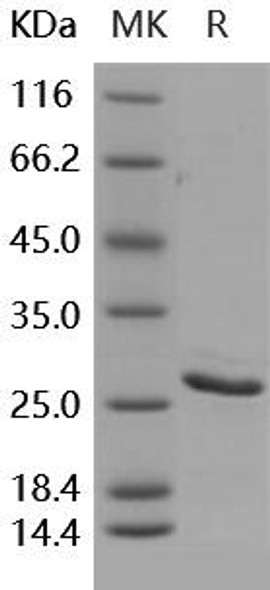Description
| Product Name: | Human BCL2 Recombinant Protein |
| Product Code: | RPPB2868 |
| Size: | 20µg |
| Species: | Human |
| Target: | BCL2 |
| Synonyms: | Apoptosis regulator Bcl-2, BCL2, B-cell CLL/lymphoma 2, Bcl-2. |
| Source: | Escherichia Coli |
| Physical Appearance: | Sterile filtered colorless solution. |
| Formulation: | The BCL2 protein solution contains 20mM Tris-HCl, pH-8, 2mM DTT and 20% glycerol. |
| Stability: | Store at 4°C if entire vial will be used within 2-4 weeks. Store, frozen at -20°C for longer periods of time. For long term storage it is recommended to add a carrier protein (0.1% HSA or BSA).Avoid multiple freeze-thaw cycles. |
| Purity: | Greater than 90.0% as determined by SDS-PAGE. |
| Amino Acid Sequence: | MGSSHHHHHH SSGLVPRGSH MAHAGRTGYD NREIVMKYIH YKLSQRGYEW DAGDVGAAPP GAAPAPGIFS SQPGHTPHPA ASRDPVARTS PLQTPAAPGA AAGPALSPVP PVVHLTLRQA GDDFSRRYRR DFAEMSSQLH LTPFTARGRF ATVVEELFRD GVNWGRIVAF FEFGGVMCVE SVNREMSPLV DNIALWMTEY LNRHLHTWIQ DNGGWDAFVE LYGPSMRPLF D |
BCL2 gene encodes an integral outer mitochondrial membrane protein that blocks the apoptotic death of some cells such as lymphocytes. Constitutive expression of BCL2, such as in the case of translocation of BCL2 to Ig heavy chain locus, is thought to be the cause of follicular lymphoma. Two transcript variants, produced by alternate splicing, differ in their C-terminal ends.
BCL2 Human Recombinant produced in E.Coli is a single, non-glycosylated polypeptide chain containing amino acids 1-211 and having a molecular mass of 25.4 kDa. The BCL2 is fused to a 20 a.a. His-Tag at N-terminus and purified by proprietary chromatographic techniques.
| UniProt Protein Function: | Bcl-2: a antiapoptotic member of the Bcl-2 family. Regulates cell death by controlling the mitochondrial membrane permeability. Inhibits caspase activity either by preventing the release of cytochrome c from the mitochondria and/or by binding to the apoptosis-activating factor (APAF-1). Phosphorylation by JNKs may increase its antiapoptotic functions. |
| UniProt Protein Details: | Protein type:Autophagy; Membrane protein, integral; Oncoprotein; Apoptosis Chromosomal Location of Human Ortholog: 18q21.3 Cellular Component: pore complex; endoplasmic reticulum membrane; mitochondrial outer membrane; nuclear membrane; mitochondrion; membrane; endoplasmic reticulum; cytoplasm; nucleus; cytosol; myelin sheath Molecular Function:identical protein binding; protein binding; protein homodimerization activity; protease binding; protein phosphatase 2A binding; protein heterodimerization activity; channel activity; sequence-specific DNA binding; ubiquitin protein ligase binding; BH3 domain binding; channel inhibitor activity; transcription factor binding Biological Process: response to nicotine; focal adhesion formation; positive regulation of catalytic activity; developmental growth; renal system process; protein polyubiquitination; pigment granule organization and biogenesis; response to toxin; response to glucocorticoid stimulus; T cell differentiation in the thymus; ear development; lymphoid progenitor cell differentiation; positive regulation of multicellular organism growth; female pregnancy; glomerulus development; negative regulation of mitochondrial depolarization; post-embryonic development; cochlear nucleus development; cellular response to glucose starvation; negative regulation of myeloid cell apoptosis; B cell receptor signaling pathway; regulation of mitochondrial membrane potential; positive regulation of B cell proliferation; negative regulation of ossification; regulation of transmembrane transporter activity; T cell homeostasis; negative regulation of neuron apoptosis; cell growth; defense response to virus; spleen development; response to drug; positive regulation of neuron maturation; release of cytochrome c from mitochondria; regulation of protein homodimerization activity; axon regeneration; actin filament organization; cell aging; digestive tract morphogenesis; regulation of calcium ion transport; positive regulation of cell growth; organ growth; DNA damage response, signal transduction resulting in induction of apoptosis; induction of apoptosis via death domain receptors; gland morphogenesis; negative regulation of osteoblast proliferation; regulation of mitochondrial membrane permeability; regulation of nitrogen utilization; metanephros development; oocyte development; negative regulation of apoptosis; B cell proliferation; negative regulation of autophagy; regulation of protein heterodimerization activity; behavioral fear response; melanin metabolic process; regulation of cell-matrix adhesion; apoptosis; negative regulation of retinal cell programmed cell death; regulation of protein stability; positive regulation of smooth muscle cell migration; protein amino acid dephosphorylation; response to radiation; ovarian follicle development; positive regulation of skeletal muscle fiber development; B cell homeostasis; positive regulation of melanocyte differentiation; melanocyte differentiation; response to gamma radiation; negative regulation of cellular pH reduction; transmembrane transport; response to iron ion; regulation of viral genome replication; negative regulation of cell migration; mesenchymal cell development; ossification; hair follicle morphogenesis; CD8-positive, alpha-beta T cell lineage commitment; thymus development; B cell lineage commitment; male gonad development; peptidyl-threonine phosphorylation; positive regulation of peptidyl-serine phosphorylation; humoral immune response; response to UV-B; endoplasmic reticulum calcium ion homeostasis; neuron apoptosis; peptidyl-serine phosphorylation; response to hydrogen peroxide; axonogenesis; ureteric bud branching; homeostasis of number of cells within a tissue; response to cytokine stimulus; innate immune response; negative regulation of cell growth; induction of apoptosis by oxidative stress; response to DNA damage stimulus |
| NCBI Summary: | This gene encodes an integral outer mitochondrial membrane protein that blocks the apoptotic death of some cells such as lymphocytes. Constitutive expression of BCL2, such as in the case of translocation of BCL2 to Ig heavy chain locus, is thought to be the cause of follicular lymphoma. Two transcript variants, produced by alternate splicing, differ in their C-terminal ends. [provided by RefSeq, Jul 2008] |
| UniProt Code: | P10415 |
| NCBI GenInfo Identifier: | 231632 |
| NCBI Gene ID: | 596 |
| NCBI Accession: | P10415.2 |
| UniProt Secondary Accession: | P10415,P10416, Q13842, Q16197, C9JHD5, |
| UniProt Related Accession: | P10415 |
| Molecular Weight: | 239 |
| NCBI Full Name: | Apoptosis regulator Bcl-2 |
| NCBI Synonym Full Names: | B-cell CLL/lymphoma 2 |
| NCBI Official Symbol: | BCL2�� |
| NCBI Official Synonym Symbols: | Bcl-2; PPP1R50�� |
| NCBI Protein Information: | apoptosis regulator Bcl-2; protein phosphatase 1, regulatory subunit 50 |
| UniProt Protein Name: | Apoptosis regulator Bcl-2 |
| Protein Family: | Bcl2-associated agonist of cell death |
| UniProt Gene Name: | BCL2�� |
| UniProt Entry Name: | BCL2_HUMAN |






